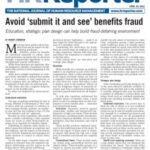Download PDF of Avoid ‘Submit it and See’ Benefits Fraud
Education, strategic plan design can help build fraud-deterring environment
BY ROBERT CROWDER
Much has been written about benefits fraud and its impact on skyrocketing premiums.
Whether claims for benefits are submitted manually or online, most fraud prevention measures rely on detection through computerized algorithms or good old-fashioned manual verification.
While these measures are important, they are designed to identify a fraudulent activity rather than prevent it from happening in the first place.
Aside from outright fraudulent or criminal activity intended to defraud the benefits plan, it is common to find employees at every company who are willing to test the boundaries of their plan for personal gain.
This abuse also has a negative financial impact on the benefits plan.
So, what can employers do about prevention?
Understand motivation
The lure of getting something for free is strong. Whether it’s throwing in a “free” pair of shoes with the purchase of orthotics or extra massage therapy sessions, an employee may feel she has nothing to lose. It’s the “Let’s submit it and see” approach.
But why do some employees, who would never consider submitting a false expense claim for travel or other work-related expense, do so regularly for benefits claims?
Submitting an expense claim clearly is a direct transaction between an employee and her employer, and the impact on the bottom line is obvious. Employees and managers are under pressure to control or reduce direct expenses.
On the other hand, a benefits claim submission is removed from the employee-employer relationship and the impact on the bottom line is often poorly understood.
This indirect relationship — combined with the perception all claims are insured with little impact on the company and the knowledge employee claims information is protected from employers by federal and provincial privacy legislation — make it an easy target for fraud and give it the appearance of a victimless crime.
Considering the motivation for fraud, there are several steps an employer can take to align employees’ interest with their own and reduce the temptation to commit fraud in the first place.
Chief among these are education and strategic plan design.
Education
While benefits are a promise an employer makes to an employee as part of her overall compensation, what is often misunderstood is the impact increased claims can have on a company’s bottom line. Employers should be clear from the outset that when a plan is abused, costs to the employer will go up and the budgetary impact of premium increases may force a reduction in benefits or increased payroll deductions for all employees.
To help plan members understand the complex nature of benefits costs, a good place to start is to explain there are two components to every benefits plan — insurance and transactional items.
Insurance: Insurance protects against catastrophic, sudden and unexpected low-frequency or high-cost events. These include life insurance, accidental death and dismemberment, long-term disability, out-of-country emergency, stop-loss insurance and critical illness.
These pooled products represent insurance in the traditional sense of the word. To reduce the impact of these types of claims, an insurer will spread the risk over a large pool of members and beyond the company itself.
Transactional items: These include medical, dental, drug, paramedical services and related claims. These benefits operate on a money-in, money-out basis rather than requiring traditional risk insurance.
This has a direct impact on a company’s bottom-line — the only variable is timing. Whereas companies that use third-party administrators to manage the plan will more quickly become aware of increases in claim costs, companies paying a fixed premium under traditional plans can reliably expect increases based on actual costs will be built in at the next renewal period. Actual claims experience will follow a company even if it switches to a new provider.
Abuse of this aspect of a benefits plan, therefore, can increase the cost of the plan for everyone, which may lead to a reduction in the benefits offered by an employer. Educating plan members about the direct impact of claims on the future viability of the plan or overall compensation may appeal to self-interest and encourage more prudent use of the plan.
Strategic plan design
Often overlooked, good plan design is one of the most effective methods available to reduce fraud and limit risk to the employer. A carefully designed plan may incorporate a number of methods to control abuse and reduce fraud such as combined maximums, health-care spending accounts (HSAs) and tiered plans.
Combined maximums: One proven way to limit the risk of abuse is to set combined maximums for services to prevent intentional run-up of costs for similar procedures. One example is a combined per-person and per-family maximum for all paramedical services claims. An unscrupulous service provider could recommend family members shift from one provider to another within their clinic to receive additional services.
Schemes such as these can be used in an effort to defraud benefits providers but setting overall maximums mitigates the damage these kinds of fraudulent claims can cause to plan costs.
Health-care spending accounts: HSAs are a plan design option that can eliminate the motivation for fraud. The overall dollar amount is limited so fraudulent claims take away from funds that could be used for an individual’s legitimate expenses.
When employees receive their Explanation of Benefits, they will see a depleting account balance and be less motivated to knowingly defraud their plan. Because it’s their own money being spent, HSAs encourage members to be more prudent with their health-care choices. HSAs can also be used as a partial alternative to core coverage. Rather than placing combined maximums on certain core portions of their plans, many employers are simply removing those portions of their plans and substituting an HSA. The employers reduce their risk while plan members gain more flexibility in their coverage and can claim based on their individual or family needs.
Tiered plans: While there are many reasons a one-size-fits-all approach may not be desirable or appropriate in a benefits plan, a tiered plan can also be designed to reward employee loyalty and to deter fraud.
Employers with high turnover may also have high claims and are at risk for abusive claim patterns. In some cases, employees with a short-term view will submit as many claims as possible during their brief tenure and negatively impact the claims experience. A company can protect itself by setting plan maximums at an increasing scale based on seniority.
Whether through the use of HSAs or combined maximums, new employees would start with a lower limit to reduce the risk to the benefits plan, and then be rewarded with higher maximums for longer service.
Ultimately, while companies must rely on benefits administrators to implement best practices in fraud detection, fraud prevention can start with the employer through education and by setting a fraud-deterring environment through strategic plan design.
Robert J. Crowder is president of the Benefits Trust in Vaughan, Ont., a third-party administrator providing custom employee benefits plans. For more information, visit www.thebenefitstrust.com.
© Copyright Thomson Reuters Canada Ltd. – April 23, 2012 – Toronto, Ontario,
(800) 387-5164 – Web Site: www.hrreporter.com







